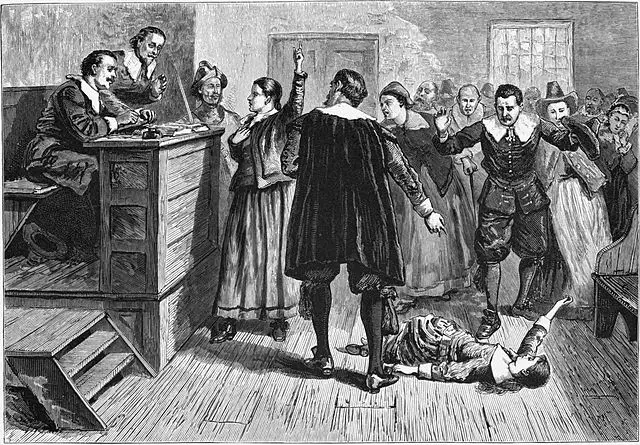The Salem Witch Trials
The era of the Salem Witch trials joins some of the most horrible in the history of the colonies and of America.
This was a time when people in European countries, as well as the New World, believed that Satan could take over the body of an individual, and when someone did simple tasks and healing, they were thought to be a witch.
A majority of those that were accused of practicing witchcraft were women, and it’s thought that this was another way of reducing the power of those women that knew natural healing practices so that the community would be male-dominated.

The Puritans brought the belief system from Europe, where thousands had been accused of witchcraft and executed.
- From 1692-1693, the witch trials took place in a lot of towns in Massachusetts Bay Colony, but most of them happened in the village of Salem.
- The first accusation of witches started in Salem when two young girls, aged 9 and 11, started having unusual fits. They would fall to the ground screaming, twitching, and making animal noises. The girls, Betty Parris and Abigail Williams said that they felt like they were being stuck with pins and pinched. When this behavior happened during a church service, those in Salem believed that this was an act of Satan.
- The young girls blamed what was happening to them on the witchcraft of three village women. One of the servants of the girls, Tituba, had told them stories of witchcraft, and it’s thought that this is where the girls got their idea. Another woman in the village was homeless and a beggar who never attended church. This woman, Sarah Osborne, was also accused of being a witch.
- Living in a cloistered community that is steeped in religious belief can be harmful as it doesn’t allow for critical thinking. Once the stories began to spread, so did panic and mass hysteria. This hysteria was topped off when Tituba confessed to being a witch and having an alliance with Satan. This caused hundreds of people of being witches, and the Puritan church pastors started witch trials using specific criteria to figure out who was a witch.
- The pastors of the area had tests that they would give to the accused for testing if they were a witch:
- If the individual that was affected by the witch was touched by the witch that cast the spell, they would become calm.
- They would dunk they accused within water until they confessed.
- If the accused couldn’t recite the Lord’s Prayer without any error, they were a witch.
- If the accused person said that they had dreams where they saw a witch working with Satan.
- Putting the accused bound into water. If they floated, they were a witch. The bad thing about this is that they would drown if they didn’t float.
- Heavy stones would be put on the accused as a way to force a confession. However, it often caused the person not to be able to breathe so they could confess if they tried.
- During the Salem witch trials, about 150 people were jailed, and some died in jail due to bad conditions, while around 20 people were executed. A majority of the people that said they were afflicted by witches were young women under the age of 20 years.
- As the mass hysteria began to die down, some began to understand that there were innocent people being accused and put to death. In 1693 the governor stopped the trials and gave pardons to those in jail that were accused of witchcraft.
Q&A:
Where did the Puritans get the idea of accusing people of witchcraft?
They brought the practice from Europe where it was accepted
What caused the first accusation of witchcraft in Salem?
2 young girls started having fits in church
What is the name when large groups of people begin to act irrationally?
mass hysteria
What age and gender were those that accused others of being witches?
young women under 20 years old
During the Salem witch trials, how many people were killed?
20
Who finally stopped the witch trials?
the governor



